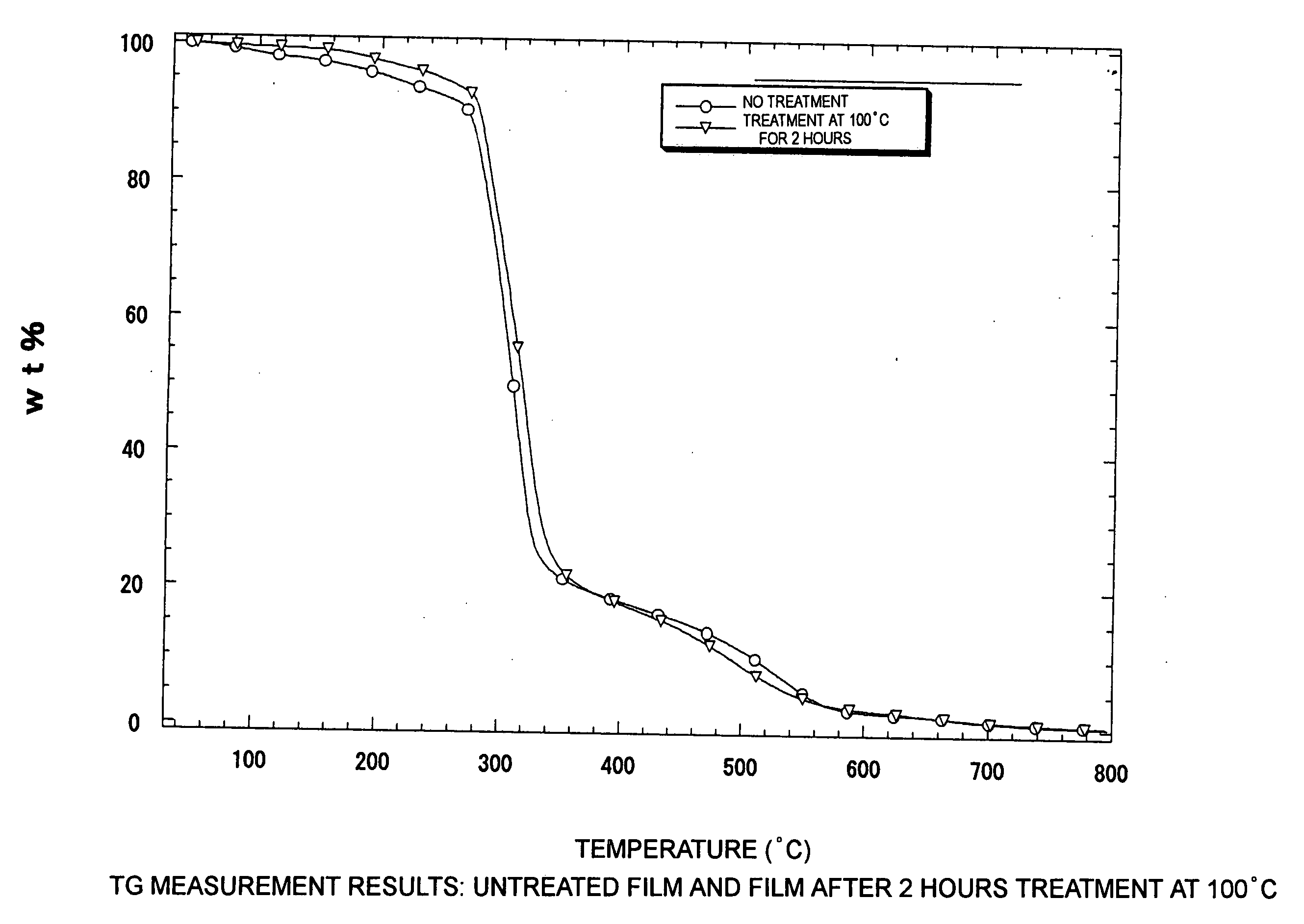Method of removing acid component in deteriorated acetate film
a technology of acetate film and acid component, which is applied in the direction of solvent extraction, cleaning with liquids, separation processes, etc., can solve the problems of deterioration progressing more seriously than expected, deterioration was not sufficiently suppressed, and deterioration was accelerated rapidly, so as to reduce the acidity, suppress the deterioration process, and reduce the acidity
- Summary
- Abstract
- Description
- Claims
- Application Information
AI Technical Summary
Benefits of technology
Problems solved by technology
Method used
Image
Examples
example 1
Extraction Treatment with Supercritical Carbon Dioxide
[0037] Deteriorated acetate film with acid odor (1.0049 g, [0.140×34.00×157.00 mm]) was sampled in a supercritical cell (diameter 4 cm, length 6 cm), and supercritical extraction was performed at 40° C. and 9.0 MPa (CO2) for 24 hours.
[0038] The film was then taken out, and vacuum-dried at 30° C. to constant weight.
[0039] When the extracted ingredients were collected by trapping a gas mixture (CO2 and extracted ingredients) with deuteriochloroform when pressure was reduced to normal pressure inside the supercritical cell.
[0040] It was found that by supercritical extraction, the weight of the acetate film decreased. At 40° C. and 9.0 MPa for 24 hours the film decreased in weight from 1.0049 g to 0.9722 g, and 3.3 wt % was extracted.
[0041] The extracted ingredients were analyzed as follows.
[0042] The molecular structures of the extracted ingredients were analyzed by 1H-NMR and 13C-NMR. From 1H-NMR, a signal was observed around...
examples 2-23
[0048] In a manner similar to the procedure described in Example 1, the extraction treatment of a deteriorated acetate film was performed, except that treatment temperature, pressure and time were variously changed in the supercritical treatment. The weight change of the sample film before and after treatment together with the treatment conditions is shown in Table 1.
[0049] After treatment, these film samples also had almost no acetic acid odor and the developed images were not spoiled. Also, it was confirmed that there was no significant change in the thermometric analysis and dynamic physical properties of the film resulting from the treatment and that only volatile acids were removed under the treatment conditions as described.
TABLE 1ABCDEFGNo.2321824155.73141.599.079No.3327.424155.87142.948.3No.4901824157.61140.8810.6No.590183157.5145.67.56No.690181155.82145.236.79No.7601820158.02142.549.8No.860183157.07145.557.33No.940183155.85144.517.28No.1040181159.22147.767.39No.114018241...
example 24
Evacuation Treatment
[0050] About 140 mg of a deteriorated film was cut out, placed in a reaction vessel, and this was connected to a vacuum system using an oil diffusion pump as follows. The reaction vessel was maintained by an oil bath at the temperatures shown below. After reaching a sufficient degree of vacuum (about 2×10−3 mmHg), the sample was left for about 1 hour. Subsequently, the bath was removed, nitrogen gas was introduced and the pressure was returned to atmospheric pressure.
[0051] The weight change of the sample film before and after treatment is shown in Table 2.
TABLE 2beforeafterdecreasetemperaturetreatmenttreatmentrate(° C.)(mg)(mg)(wt %)40138.31134.822.5265144.21140.272.7390141.30136.593.33
[0052] There was almost no acetic acid odor from the film after treatment, and the developed image was not spoiled. Also, it was found that there was no significant change in the thermometric analysis and dynamic physical properties of the film resulting from the treatment, an...
PUM
| Property | Measurement | Unit |
|---|---|---|
| TG | aaaaa | aaaaa |
| temperature | aaaaa | aaaaa |
| RH | aaaaa | aaaaa |
Abstract
Description
Claims
Application Information
 Login to View More
Login to View More - R&D
- Intellectual Property
- Life Sciences
- Materials
- Tech Scout
- Unparalleled Data Quality
- Higher Quality Content
- 60% Fewer Hallucinations
Browse by: Latest US Patents, China's latest patents, Technical Efficacy Thesaurus, Application Domain, Technology Topic, Popular Technical Reports.
© 2025 PatSnap. All rights reserved.Legal|Privacy policy|Modern Slavery Act Transparency Statement|Sitemap|About US| Contact US: help@patsnap.com


